A review of the kingdom plantae indicates that the seed-plants spermatophytes predominate over non-seed vascular plants. One of the most significant events in the history of land plants was the development of seed habit. It was an important change in the reproductive system of the vascular plants which occurred approximately 390 million years ago.
First complete seeds appeared approximately 365 million years ago during late Devonian times. Technically a seed may be defined as a fertilized ovule. An ovule is an integument indehiscent megasporangium. Integuments are specialized protective coverings around megasporangium which vary in number. All seed producing plants are called Spermatophytes. Various steps involved in the evolution of seed habit are as follows.
- Evolution of heterospory.
- Retention and germination of megaspore within the megasporangium.
- Development of protective layers around megasporangium.
- Reduction to a single functional megaspore per sporangium.
- Development of an embryo sac within the sporangium.
- Modification of distal end of megasporangium for pollen capture.
Evolution of heterospory
Primitive vascular land plants produced one kind of spores, a condition called homospory. All groups of land plants up to pteridophytes are homosporous. During the early phase of evolution some plant groups started producing two different types of spores, the smaller ones called microspores and the larger ones known as megaspores.
The microspores produced inside microsporangia germinate to form male gametophyte or the microgametophyte, whereas the megaspores germinated to form female gametophyte or megagametophyte.
Retention and germination of megaspore within the megasporangium.
During the usual reproductive cycle in the heterosporous vascular land plants, the megaspores are used to be shed and dispersed soon after their formation in order to germinate into female gametophyte. However in some plants (e.g. Selaginella) the megaspore is not allowed to escape from megasporangium immediately after its formation. In others the megaspore is permanently retained within the megasporangium. Here, within the confines of the megasporangium wall the megaspore germinates to form egg containing female gametophyte.
Development of protective layers around megasporangium
Some branch like structure of sporophyte surrounding the megasporangium fused around to megasporangium to form protective envelope or integument. The megasporangium tightly locked by integuments becomes totally indehiscent. This important change led to the evolution and formation of the ovule, which is nothing but an integumented indehiscent megasporangium. In this way more protection is accorded to the egg-containing apparatus in terrestrial environment.
Reduction to a single functional megaspore per sporangium
Each megaspore mother cell within a megasporangium used to produce four gametophytes. There was a competition for space and food among the four gametophytes. Soon the early vascular plants adopted a new strategy i.e., only one megaspore is selected for further development into a healthy female gametophyte while the remaining three are aborted.
Development of an embryo sac within the sporangium
The single healthy megaspore retained within the megasporangium germinates to form an egg containing female gametophyte called an embryo sac.
Modification of distal end of megasporangium for pollen capture
When most of the structural and functional changes leading to the development of seed habit were completed, another important modification took place in the megasporangium which was now integumented, indehiscent and permanently attached to the sporophyte. The distal end of the megasporangium became modified for capturing pollen (microspore containing male gametophyte).
Pollen after being trapped in the distal cavity of the megasporangium produces pollen tube which carry male gametes deep into the embryo sac to fertilize the egg, forming a zygote, that forms an embryo. The megasporangium (ovule) after fertilization is transformed into a seed, the integuments becoming the seed coats. The seed offers maximum degree of protection to a developing embryo under the unfavorable terrestrial environment. The development and evolution of seed habit was a great success and a giant leap which ultimately enabled plants to colonize land permanently.

Gymnosperms
Gymnosperms are one of the successful groups of seed plants of worldwide distribution. They constitute about one-third of the world’s forests. The gymnosperms are heterosporous plants which produce seeds but no fruits. The term gymnosperm literally means ‘naked seeded’ (Gymno=naked, spermae= seed). The ovules in these plants are usually borne on the exposed surfaces of fertile leaves (megasporophylls). These ovules, unlike those of angiosperms are not enclosed but lie naked on the surface of fertile leaves.
Like filicinae, they show regular heteromorphic alternation of generations. They have independent, dominant sporophyte but less conspicuous, dependent gametophyte. The female gametophyte is permanently retained within the ovule. The two kinds of spores are microspores and megaspores which develop on microsporophylls and megasporophylls respectively. The megasporophylls bearing ovules are not folded and joined at the margins to form an ovary. For this reason the seeds lie naked on the mega sporophylls, (Fig. 9.20a).
The important genera are Cycas (sago-palm) (Figs. 9.20-a), Pinus (pine), taxus (Yew), picea (hemlock) and Cedrus (deodar) Ginkgo (Fig. 9.20=b) etc.
Pinus- Life Cycle
The pine is a conifer. The main plant body is saprophyte which produces spores after reduction division of spore mother cell in sporangia. Conifers are heterosporous. Microspores and megaspores are produced in microsporangia and megasporangia respectively. Sporangia (i.e, micro and megasporangia) are produced on respective cones (male cones and female cones) on the same plant.
The male cones are small in size and are produced in clusters on an axis. Each male cone consists of microsporophylls which contain microsporangia. Microspore germinates to form a small inconspicuous male gametophyte (also called as microgametophyte) within the spore wall. Such a microspore of seed plants that contains the microgametophyte including the gametes is called a pollen grain (plural = pollen).
Pollen are produced in great numbers and are transported by wind. Pollen grain in pinus has two wings attached to its lateral sides. Due to wings, pollen can float in air for a longer period of time and can travel long distances. The gymnosperms have successfully evolved this totally new mechanism of transfer of male gamete to the female gametophyte through wind which has made them independent of water for this purpose. This is an important improvement and evolutionary adaptation to survive in the harsh dry terrestrial (land) environment.
During pollination the pollen land directly on the ovules. Only few pollen are able to germinate to form pollen tubes through which male gametes are transferred to the embryo sac for fertilization.
More than one egg can be fertilized to form several zygotes, but one zygote usually survives to form a single embryo. After fertilization the ovule becomes the seed. The seeds now contains an embryo along with some stored food material. The seed upon germination gives rise to a new sporophyte plant.
In the life cycle of pinus, the dominant diploid sporophyte generation alternates with inconspicuous haploid gametophyte generation (Fgi. 9.21)
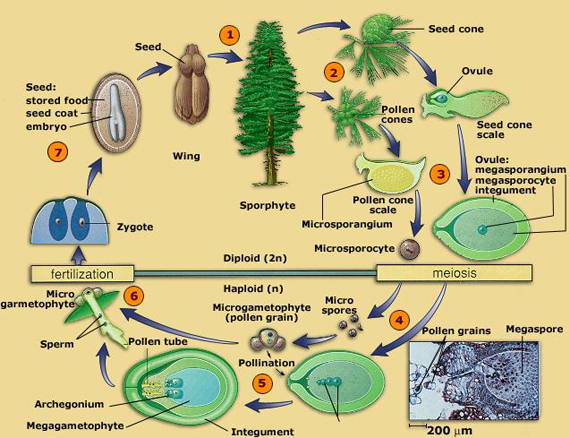
Class Angiospermae
The term angiosperms literally means “enclosed seeded” (angio=close sperm=seed). In these plants fertile leaves bearing ovules are folded and joined at the margins to form ovaries. The ovary after fertilization is changed into a fruit, containing seeds.
Angiosperms make up 235,000 of the 360,000 known species of plants. They are heterosporous, autotrophic plants. These are highly evolved of all the plants on the earth. The plants produce flowers, fruits and seeds.

(a) |

(b) |

(c) |
Fig. 9.22some of the remarkable diversity of angiosperms is shown in these photographs. The species shown here are dicots (a) fragrant water lily, (b) wild geranium, (c) Indian pipe (aparsite) an angiosperm that lacks chlorophyll.
Life cycle of an angiospermic plant
The adult plant is a diploid saprophyte mostly differentiated into roots stem and leaves. At maturity it produces flowers. A flower is a modified shoot which consists of a pedicel, thalamus or torus, and floral leaves (sepals, petals, stamens and carpals). Thalamus and floral leaves, especially the stamens and the carpals, are so modified, that they do not even look like stem and leaves respectively. The sepals and petals are non-essential or non-reproductive parts, and stamens and carpals are the essential or reproductive parts of the flower.
The sepals and the petals protect the stamens and the carpals. They also attract insects for pollination. When the pollination is over, the sepals usually and the petals always fall off.
The anther contains microspore mother cells which produce haploid microspores through mitosis. Each microspore germinates to produce male gametophyte. Such microspores containing male gametophytes are called pollen.
The carpel consists of a basal broader apt, the ovary, the style and the, terminal part of the style. The stigma. The ovary contains ovules. The ovule consists of an integument (covering) and a tissue, the nucleolus present inside.
After pollination, the pollen grain is transferred to the stigma. Here it germinates to form a pollen tube. The nucleus of the microspore divides by mitotic divisions to form two male gametes and the tube nucleus. At this stage of development, the pollen grain is called male gametophyte. In the meantime certain changes occur in the ovule leading to the formation of female spore (megaspore). The megaspore develops into female gametophyte. This consists of seven cells only. One of these cells is the egg of oosphere.
The pollen tube grows through the style, enters the ovule and then reaches the female gametophyte. Here it discharges the male gametes. The egg and one of the two male gametes fuse to form the oospore. The second male gamete fuses with the secondary nucleus to form endosperm nucleus (double fertilization). The oospore develops into an embryo and endosperm nucleus develops into a multicellular nutritive tissue, the endosperm.
Seed formation
Meanwhile, the integuments of the ovule form testa and tegmen and ovary wall develops into the fruit. Seeds usually undergo a period of rest and then under suitable conditions, germinate and produce a seedling which gradually changes into a sporophyte (fig. 9.23).
Thus an alternation of dominant sporophyte generation (2n) occurs with inconspicuous gametophyte generation (n).
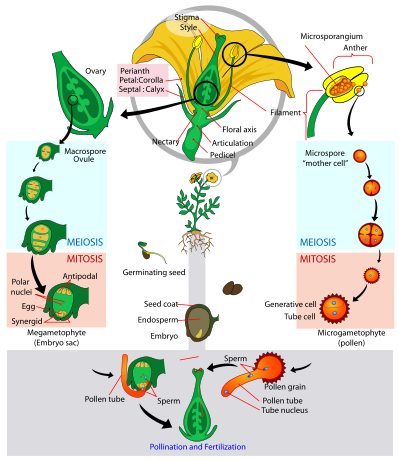
Fig. 9.23 life cycle of an angiosperm plants.
Classification Of Angiosperms
Double fertilization is a special process found in angiosperms. In this two male gametes fuses with two cells simultaneously.a male gamete (n) fuses with egg (n) to form a diploid zygote (2n) which develops later into an embryo and second male gamete (n) fuses with another female cell called fusion nucleus (2n) resulting into a triploid (3n) endosperm cell, which develops into food storing endosperm tissue. It is an important evolutionary advancement in which food storage fertilized ovule is made only on fertilization i.e. formation of zygote. This actually helps the plant to economize its food resources.
Classification of angiosperms
The class angiospermae is divided into two sub-classes, the monocotyledonae (with one cotyledon) and the dicotyledonae (with two cotyledons), according to the number of cotyledons in the embryo.
The plants included in the monocotyledonae are called monocotyledonous plants or monoocts. The plants included in the dicotyledonae are called dicotyledonous plants or dicots. A few distinguishing characters of the two classes are given below:
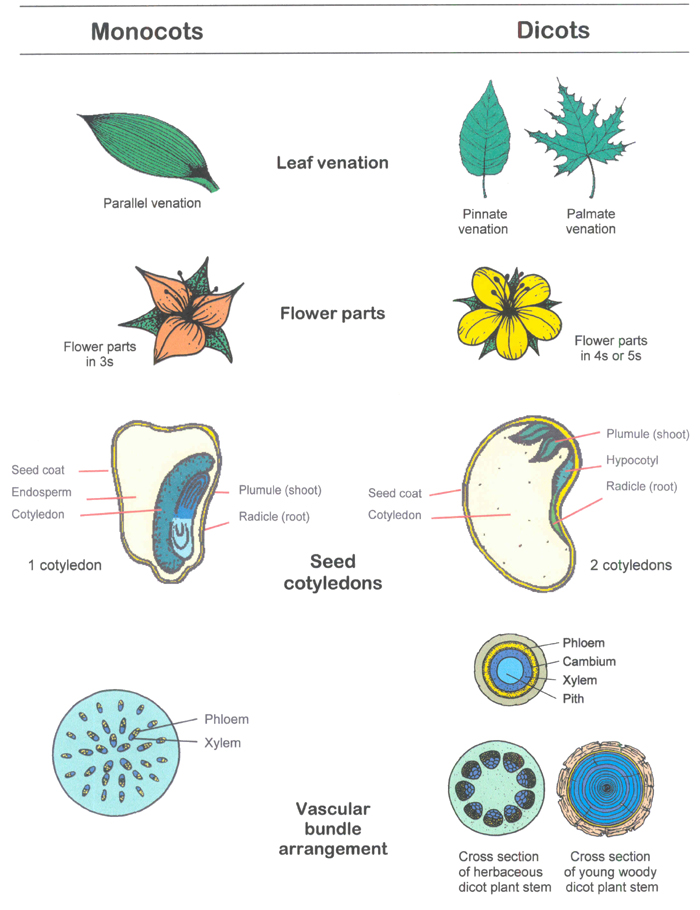 Fig. 9.24comparison of dicot and monocot
Fig. 9.24comparison of dicot and monocot
Anglospermic familes
Some angoispermic families are described below:
- Rosaceae (Rose family)
- Solanaceae (potato family).
- Fabaceae (pea family).
- Caeselpiniaceae (cassia family).
- Mimosaceae (acacia family).
- Poaceae (grass family).
Rosaceae (rose family):
A family with about 100 genera and 2000 species is distributed over most of the earth. In pakintan 29 genera and about 213 species are reported.
Familiar plants: pyrus (pear): rosa (rose); malus (apple); fragaria (strawberry) etc.
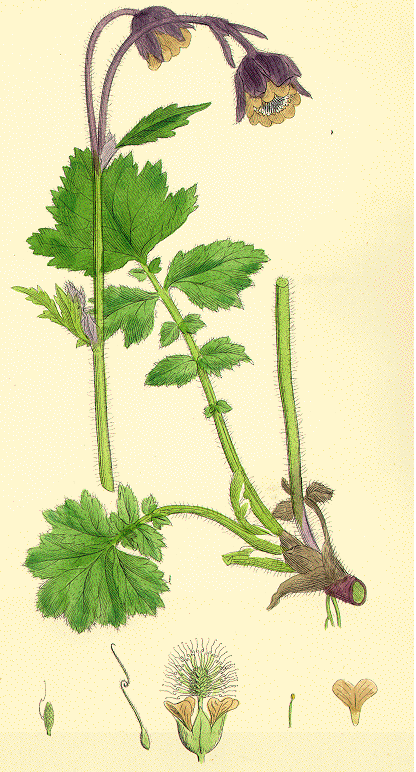
Fig. 9.25Rosaceae: A-twig: B-young stamen B1-enlarged open anther, showing pollen in it: C-style hairy and stigma bilabiate: C1-enlarged bilabiate stigma.
Vegetative characters
Plants are trees, shrubs and herbs. Stem of the shrubby plants usually have spines. Leaves are alternate, rarely opposite, simple or compound, with paired stipules which are sometimes adnate to the pertiole; spines may also occur on the rachis.
Floral characters
Inflorescence is variable, solitary or may be racemose or cymose cluster. Flowers are mostly bisexual, and actinomorphic, often perigynous to some degree, usually showy and scented. Calyx: 5 sepals rarely 4, united at the base. Corolla: petals 5, or numerous in multiple of 5, which are free rosaceous, large and showy. Androecium: numerous stamens, sometimes only 5 or 10. Gynoecium is of 1 to numerous separate carpels or variously united, ovary generally superior sometimes inferior; Placentation basal, when the carpel is one or apocarpous, but axile when the carpels are many and syncarpous (fused).
Economic importance: economic importance of this family is great in providing the pleasure and welfare to manking. The members of this family are important in temperate regions for fruit and ornamentals. Perhaps they rank third in commercial importance in the temperate zone among the families of flowering plants.
Important fruits are apple, pear, peach, almond, apricot, strawberry, etc.
A large number of plants are ornamental and are grown in gardens for their beautiful and scented flowers. The most widely cultivated genus for decorative purpose is Rosa, Rose which has been grown in gardens since ancient times and whose named cultivars are now numbered in thousands. Many other genera are also grown for their beautiful flowers in the parks and gardens.
The branches of crataeugs provide excellent walking sticks and wood. The wood of pyrus pastia is used for making tobacco pipes.
In Asian countries the petals of common rose usually called gulabs are used in making gulkand, and are also used in extraction of an essential oil (rose oil) used as perfume, when distilled with water the petals give Rose-water or Ark-Gulab, which is used for curing eye disease, and for many other purposes.
Solanaceae: Night Shade or Potato Family
It is family of about 90 genera and 2000 species of tropical and temperate distribution. In Pakistan 14 genera and about 52 species are reported, Nasir (1985).
Familiar Plants: solanum tuberosum (potato), nicotiana tabacum (Tbacco), lycopersicum esculentum( Tomato), Capsicum frutescens (Red pepper).
Vegetative Characters: plants including in this family are herbs, shrubs, sometimes trees or vines. Stem is hairy or prickly. Leaves are alternate or rarely becoming opposite in the floral region, simple, petiolate, rarely sessile.
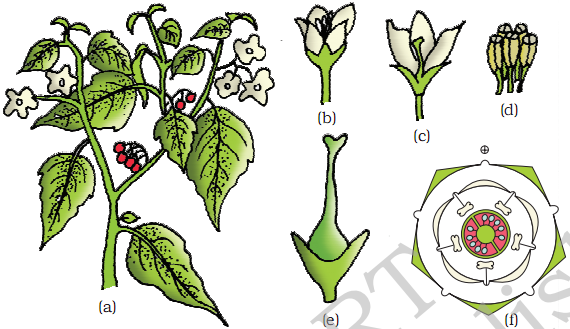
Fig. 9.26Solanaceae: Solanum nigrum, A – twig, B-Flower C-fruit, D-seed
Inflorescence: Typically an axillary cyme or combination of cymes, sometimes helicoids, or axillary umbellate cymes. Flowers: Mostyly bisexual, usually actinomorphic or weakly zygomorphic, hypogynous, usually pentamerous. Calyx: United 5 sepals, usually persistant. Corolla: united 5 petals, corolla rotate to tubular. Androecium: stamens 5, free but inserted on the corolla tube (epipetalours) rarely stamens 4 and didynamous ( arranged in two whorls of 2 each). Gynoecium: A compound pistil of 2 united carpels; ovary obliquely placed, superior bilocular, or imperfectly 4-locular by false septum; Placentation axile.
Economic importance: Members of the family solanaceae provides drugs and food, some are weedy, some are poisonous, and others are handsome ornamentals. The most important plant in the family is Solanum tuberosum (potato-white or Irish Potato). In Ireland people are completely dependent on potatoes.
Lycopersicum esculentum (tomato), the favorite home garden vegetable, was once believed to be poisonous.
Other important food plants are Solanum melangena (egg plant or brinjal). The fruit of capsicum annum and capsicum frutescens are rich in vitamin C and A, are used as condiment. Physalis (Ground-cherry) produces an edible fruit enclosed in a bladder like persistent calyx, the husk, giving the name husk tomatoe.
Another plant of great commercial value is Nicotiana tabacum the leaves of which are dried and made into tobacco, which is used in making cigarettes. Many members of this family yield powerful alkaloids, e.g. atropa belladonna, datura which are rich in atropine and daturine respectively are used medicinally.
Many plants are cultivated in the gardens for their beautiful flowers, these includes petunia, Nicotiana, Cestrum and Solanum etc.
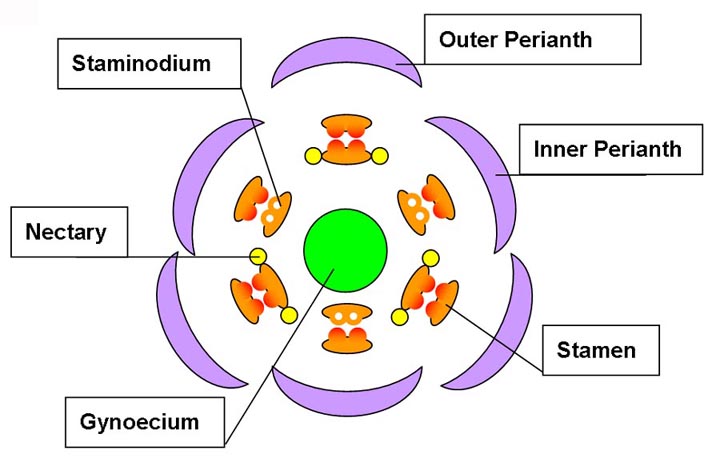
Pea Family A family of about 400 genera and 9000 species, the members of this family occurs all over the world, but particularly in the warm temperate regions. In Pakistan about 82 genera and about 587 species have been reported.
Familiar plants: Lathyrus odoratus (sweet pea), Arachis hypogeal (peanut), Cicer arietinum (chick pea) and dalbergia sissoo (shisham).

Fig 9.27 Fabaceae (Papilionaceae): Sesbania sesbar; A-twig; B-flower; B1 standard verillium; C-fruit a legume; D-carpel
Vegetative characters: habit: trees shrubs or herbs. Stem: herbaceous, or woody or climber by tendrils (wiry, coiled thread like structures). Leaves: compound or rarely simple, sometimes partially or completely modified into tendrils, alternate, stipulate; stipules mostly leafy.
Floral characters: Inflorescence: Racemose or solitary axillary. Flowers: bisexual,zygomorphic, bracteates, pedicellate, perigynous, pentamerous and papilionaceous.Calyx: 5sepals, more or less united in a tube, mostly hairy. Corolla: papilionaceous; petals 5, usually clawed, dissimilar; the upper posterior petal is large and conspicuous and is called standard or vexillum, 2-lateral ones free called wings and 2 anterior inner most that fuse to form a boat-shaped structure called the keel or carina. Androecium: stamens 10, mostly diadelphous (united by their filaments in 2 groups), 9 fused to form a sheath round the pistil, while 10th posterior one is free. Gynoecium: a simple pistil, 1-carpeled, with 1-locule; ovary superior; ovary and style long, style bent at is bar, placentation (mono carpellary) marginal. Fruit: usually a legume or pod, showing a great variety of form in various species.
Economic importance: the family is of considerable importance as a source of high-protein food, oil, and forage as well as ornamentals and other uses. Main importance lies in the pulses, belonging to this family, which are used as food, some important and common species of pulse yielding plants are: gram, pea, kidney bean. These pulses are rich in protein contents.
Medicago sativa Alfafa is one of the world’s best forage crop for horses. Vicia, Melilotus and Trifolium are also cultivated as main fodder crops. Many trees of this family provide excellent timber for building, furniture and fuel. Main timber plants are butea. Dalbergia etc.
Seeds of arachis hypogeal peanut are edible and also used for extraction of peanut oil which after hydrogenation is used as a vegetable oil. Indigo dyes are obtained from indigofera tinctoria and butea monosperma, yielding yellow dye from flowers.
Many plants of this family are important for medicines: these include Glycyrrhiza glabra for cough and cold, and Clitoria ternatea is used against snake bite. The red and white seeds of abrus precatorious are used by jewelers as weights called “ratti”. Some important ornamental plants include lathyrus, lupines, Clitoria, butea etc.
Caesalpinia Ceae: Cassia Family
Evolution of Seed Habit: This family includes about 152 genera and about 2300 species. In Pakistan the family is represented by 16 genera and about 60 species.
Familiar plants: Tamarindus India; cassia fistula. Bauhina veriegata.

Fig. 9.28Caesalpiniaceae: Cassia senna; A twig, B-flower; C-fruit
Vegetative Characters Habit: mostly trees or shrubs, some are woody climbers; rarely herbs. Stem: Erect, woody herbaceous, or climbing. Leaves: compound, pinnate, very rarely simple, stipulate.
Floral characters: Inflorescence: Axillary or terminal raceme or panicle or spikes, rarely cymose; showy. Flowers: bisexual, zygomorphic, rarely actinomorphic, perigynous. Calyx: sepals 5, free or connate at base, often colored. Corolla: mostly 5 petals, free. Androecium: stamens 10 or fewer, rarely numerous, free or variously united. Gynoecium: a simple pistil 1-carpel; ovary superior, unilocular; placentation marginal; stigma simple. Fruit: legume.
Economic importance: the family is of great importance. Some plants are ornamental, some have medicinal importance, a few have food and other values.
The leaves of Cassia alata are used to cure ring worm and skin diseases. Cassia senna and C. obovata are cultivated for the leaves which yield the drug Senna, which is the base for a laxative. Oil extracted from the seeds of Cynometera cauliflora is applied externally for skin diseases.
Common ornamental plants are bauhinia variegate (kachnar),cassia fistula (amaltas), parkinsonia, etc.
The leaves and flower’s bud of bauhinia variegate are used as vegetable. The acidic fruit of tamarindus indica are edible and are rich in tartric acid. The bark of Bauhinia and Tamarindus Indica is used in tanning. The heartwood of Haematoxylon (longwood) yield the dye haematoxylin.
Mimosaceae: Mimosa or Acacia Family:
A family of about 56 genera and about 2800 species. In Pakistan it is represented by 11 genera and 49 species, of these only 4 genera and 18 species are native and rest are introduced.
Familiar plants: acacia nilotica, albizzia lebbek, mimosa pudica Touch me not,prosopis glandulosa, P.cineraria.
Vegetative characters: habit: mostly trees or shrubs, rarely climbers or herbs. Most of themare xerophytes. Stem: mostly woody. Leaves: pinnate by compound, alternate, stipulate, stipules modified into thorns.
Floral characters: Inflorescence: spike like or head or umbel, rarely racemose or globose umbels. Flowers: Bisexual, actinomorphic, hypogynous to slightly perigynous, bracteates. Calyx: usually sepals 5, generally fused, toothed or lobed. Corolla: petals 5, free or fused; corolla lobed. Androecium: stamens 5 to numerous, free, or adnate to the base of corolla. Gynoecium: a simple pistil of 1 carper, ovary unilocular, superior; ovules many, placentation marginal. Fruit: a legume dehiscent or indehiscent.
Economic importance: many trees of this family including species of Acacia, Albizzia and Xylia provide commercially important wood, which is used for construction purpose or for furniture or as a fuel. The wood of Albizzia lebbek is used in cabinet work, and railway carriages.
Arabic gum is obtained from Acacia nilotica and A. Senegal. Katha a dye is obtained from Acacia catechu. The tender leaves of Accacia nilotica are used as blood purifier.
Some common garden plants grwn for their beautiful flowers are mimosa pudica and Acacia melanoxylon. A few species of prosopis are planted in the arid zones for breaking the wind pressure.
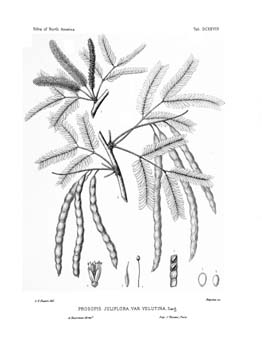 Fig 9.29 Mimosaceae: Prosopsis cineraria; A-twig, B-infloresence; C-flower; -D-fruits.
Fig 9.29 Mimosaceae: Prosopsis cineraria; A-twig, B-infloresence; C-flower; -D-fruits.
Poaceae: (Gramineae) Grass Family
Distributed throughout the world wherever vascular plants can survive. It includes about 600 genera, 10,000 species. In Pakistan it is represented by 158 genera and 492 species.
The traditional family name Gramineae takes its name from the latin Grammar which was used as a ‘ generic’ name for certain grasses, is permitted by the International Code of Binomial Nomenclature, which also provides for the use of Poaceae, based upon they type genus Poa Linn.
Familiar Plnats: Triticum vulgare, Wheat; Zea mays, Corn; Avena Sativa, Oats; Oryza sativa, Rice; Bambusa, Bamboo; Saccharam officinarum Sugar Cane etc.
Vegetative Characters: habit: annual or perennial, herbs. Stem: jointed usually hollow at the internodes, closed at the nodes. Leaves: solitary at the nodes, sometimes crowded at the base of the stem, alternate. Exstipulate, ligulate, mostly sessile, leaf-base mostly sheathing, simple.
Inflorescence: mostly compound composed of units called spikelets which are variously arranged (indense clusters as in wheat, compound spike, or loosely on branched axis-as in oats, spikelets consisting of bracts, arranged along a slender axis (called rachilla) the two lower bracts (called glumes) which are empty: the succeeding lemmas enclosing a flower and opposed by a hyaline scale called palea. The whole (lemma, palea, and flower) termed as floret: the glumes or lemmas often bearing one or more stiff bristles (called awns); this basic pattern of spikelet structure is consistent throughout the family. Spikelets of grasses vary widely in different genera, particularly as to number of fertile florets in each, and deposition of sexes with them.
Flowers: Usually bisexual, sometimes unisexual, small and inconspicuous, sessile, bracteates, incomplete, zygomorphic, hypogynous. Perianth: Absent or represented by 2, (rarely 3), minute hyaline or fleshy scales called lodicules. Androecium: Stamens 1 to 6, usually 3. With – delic compound pistil of 3 united carpels, anthers versatile through only one is functional free stigmas usually large feather like. Fruit: graius or caryopsis (caryopsis a dry, indehiscent fruit in which fruit wall (percarp) is completed, fused with seed coat).
Economic Importance: Economically family Poaceae has greater importance than any other family of flowering plants. It has great economic importance to both man and animals. Cereals and millets which constitute the chief food stuff of mankind, belongs to this family. Most of the fodder crops, which are equally important to domestic animals, also belong to this family.
Plants providing food for man includes: Triticum sp. (wheat), Avena sativa (Oats), Zea mays (Corn, Maize), Oryza sativa (Rice), Hordeum vulgare (barley), Secale cereal (Rye), Penisetum typhoideum; Sorghum vulgare etc.
The dried stem and leaves of the cereal crops are used as fodder for the cattle. Sugar is obtained from the juice of Saccharum officinarum (Sugar Cane). Many grasses are used in the lawns e.g. Agrostis, Poa, Festuca etc. and have ornamental significance.

Fig. 9.30 Poaceae (Gramineae): Chloris barbata: A habit; B-spikelet: C-gulumes: D-fertile lamma, E-flower: F-fruit;
Bambusa (Bamboo) are used as building material for the thatching huts, making boats, carts, pipes etc. and the split stem are woven into mats, baskets, fans, hats, course umbrella. Leaves are also given to horses as a cure of cough and cold etc. certain grasses yield aromatic oils, e.g. Cymbopogon citrates (lemon grass) which yield lemon grass oil is used in perfumes and soap industry and for making infusions. Some species of the grasses are used in making papers.
Ethyl alcohol and many other kind of beverages are also prepared from cereals for example whisky from Rye, barley, corn and rum molasses from sugar cane. Fibers obtained from the leaves of Saccharum munja which is used in making ropes.


